Menus
- The great athlete test in the Alps
- The athletes of the Alpine Masters 2012
- Bimota DB9 Brivido SC
- BMW S 1000 RR
- Ducati 1199 Panigale
- Kawasaki ZZR 1400 (winner)
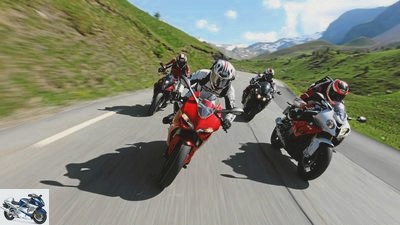
Jahn
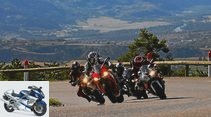
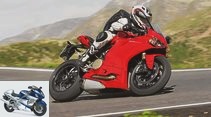
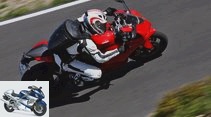
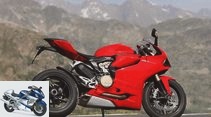
17th photos
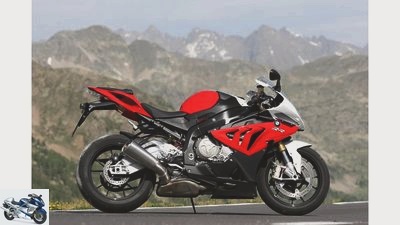
Jahn
1/17
BMW S 1000 RR: Despite the stiff chassis, the BMW offers excellent feedback. However, a noticeable righting moment when braking is to be criticized.
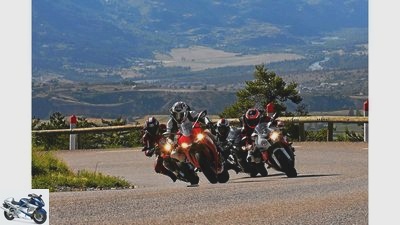
Jahn
2/17
The athletes of the Alpine Masters 2012.
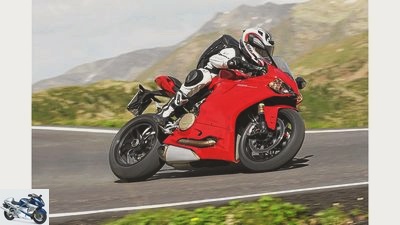
Jahn
3/17
Ducati 1199 Panigale: The heating coil called the manifold under the seat of the Panigale burns through leather suit and underpants in a matter of minutes.
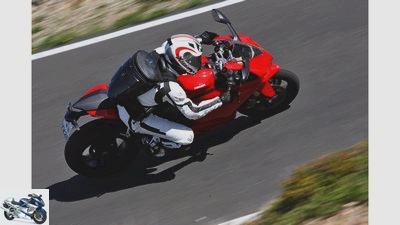
Jahn
4/17
Ducati 1199 Panigale: The red diva is doing surprisingly well in the Alps. Especially because their traction control is a real help on the difficult ride out of the tight bends.
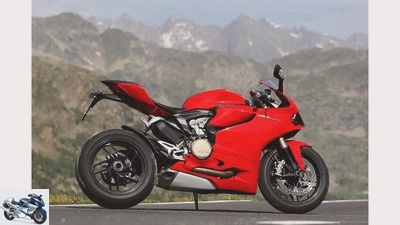
Jahn
5/17
Ducati 1199 Panigale: The Panigale impresses with its great handling and the fine regulation of ABS and traction control. Only the loud exhaust sound is annoying and the shock absorber is too hard.
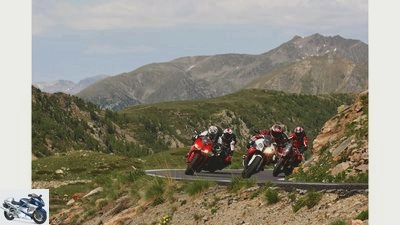
Jahn
6/17
The athletes of the Alpine Masters 2012.
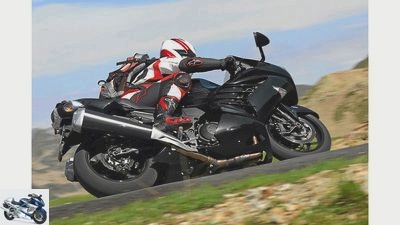
Jahn
7/17
Kawasaki ZZR 1400: The long tank of the Kawasaki mutates in turns into a rack even for tall people.
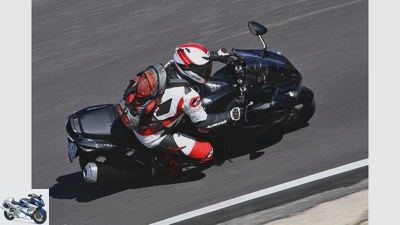
Jahn
8/17
Kawasaki ZZR 1400: On the evening lap or on the racetrack, the ZZR does not beat the ascetic racers. In the Alps, you see with qualities that sports enthusiasts cannot offer: comfort, running culture and good manners.
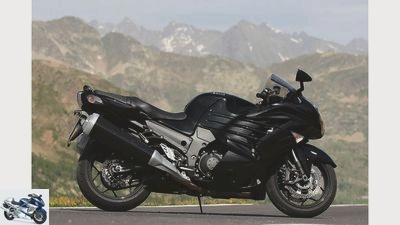
Jahn
9/17
Kawasaki ZZR 1400: A bearish engine and good handling for the vehicle mass ensure that the Kawasaki is crowned the winner among the athletes. This does not change the strong righting moment when braking and the unfavorable handlebar offset.
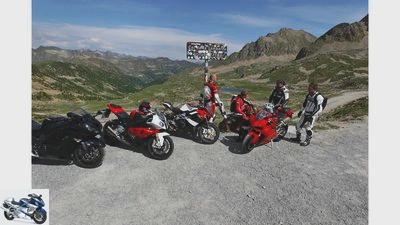
Jahn
10/17
Despite, or perhaps because of, the high level of exposure, it is a motorcycle feeling that can hardly be surpassed in intensity to be on the road with modern sports motorcycles in the Alps.

Jahn
11/17
Four modern sports motorcycles compete against each other in the Alps: Bimota DB9 Brivido SC, BMW S 1000 RR, Ducati 1199 Panigale and Kawasaki ZZR 1400.
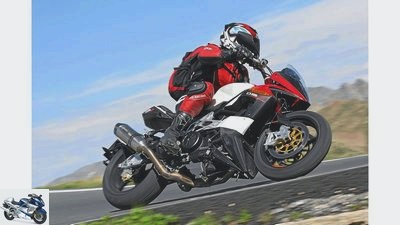
Jahn
12/17
Bimota DB9 Brivido SC: The rock-hard chassis complements the upright sitting position as a top-class sledgehammer for the spine.
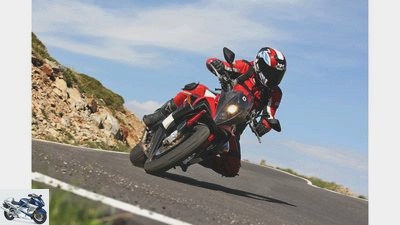
Jahn
13/17
Bimota DB9 Brivido SC: The powerful Ducati V2 is convincing. "Like an avalanche, only uphill", one is amazed who is confronted with the power of this engine for the first time.
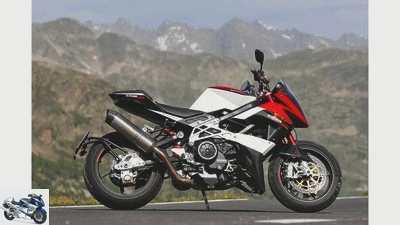
Jahn
14/17
Bimota DB9 Brivido SC: The exemplary performance development over the entire speed range and the low weight ensure a high entertainment value. Unfortunately, the Bimota is very expensive and hard-wearing.

Jahn
15/17
It’s how exercise always is. A challenge to people and material.
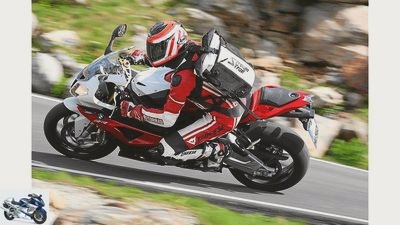
Jahn
16/17
BMW S 1000 RR: The brute brake of the S 1000 RR, in combination with the low handlebars, regularly inflates untrained forearms in Popeye format when braking downhill.
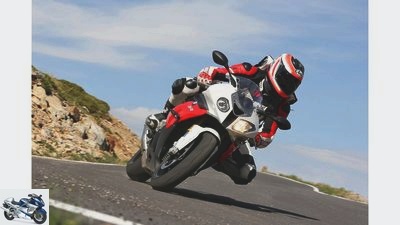
Jahn
17/17
BMW S 1000 RR: The BMW makes everything a little smoother than the competition. After the latest facelift, it is noticeably gentler on the guest, thanks to a shorter gear ratio it pushes more evenly and the rear is much more sensitive.
Alpine Masters 2012: Athletes
The great athlete test in the Alps
For some it is pure horror, for others it is blissful intensity. Bent over by the hairpin bends, head back, looking up, every hump a blow in the back. Blowing the Alps with the latest sports motorcycles still has its charm. Bet that?
The athletes of the Alpine Masters 2012
The cabinet of high alpine athlete atrocities knows many facets. The rock-hard spring strut of the Bimota Brivido complements the upright sitting position as a top-class sledgehammer for the spine, the heating coil called Krummer under the seat of the Ducati Panigale burns in minutes through leather suit and underpants, the long tank of the Kawasaki ZZR 1400 also mutates in turns for tall people to the rack and the brute brake of the S. 1000 RR, in combination with the low handlebars, regularly inflates untrained forearms in Popeye format when braking downhill. No question about it: with modern sports motorcycles in the Alps – that’s hard work, sometimes painful and not necessarily as fast as it feels. But it’s also a motorcycle feeling that is hard to beat in terms of intensity. It is unique to climb the passes in formation flight, ducking low, successfully avoiding all outbreaks of frost and rock falls, doing magic on the clutch lever and throttle and being the first to reach the top of the pass. It’s how exercise always is. A challenge to people and material.
No question about it, here at Col de la Lombarde and Col de la Bonette, the driver and vehicle are extremely challenged, in very different ways in this year’s team of athletes. Example seating position: Of course, this year’s superstars are in
Superbike high-performance field, the Ducati Panigale (this time as a standard version, i.e. without an electronically adjustable suspension) and the BMW S 1000 RR, in agreement. The handlebars are low, the footrests high, but compact and gathered. This is how you storm pole position on the world’s racetracks, but not without stress the summits in the French-Italian border area. Whereby: Bergan, the agony is only half as bad, the extremely transparent feeling for the front wheel on both of them almost makes up for the Hans-peep-in-the-air attitude.
archive
The performance of the four athletes.
Downhill, on the other hand, world champions would like the higher handlebars of the fat Kawasaki or – even better – the wide, high superbike handlebars of the Bimota and thus a better overview of the game. Their peculiar mixture of super-powerful Ducati twin (the eleven-degree Testastretta engine comes from the Diavel and mobilizes real 151 hp on the MOTORRAD test bench), light as a feather (195 kilograms with a full tank), race-track-like chassis set-up and an upright sitting position is in advance anyway an insider tip for high alpine terrain, and the DB9 fully meets these expectations. At least when the only thing that counts is driving dynamics and experience. “Like an avalanche, only uphill”, amazes someone who is confronted with it and the power of this V2 for the first time. Indeed: The Ducati Twin, which has been given a new mapping in Rimini, sweeps everyone away, regardless of the current speed and speed. Her particular strength: uphill from a slow pace to stamp out all opponents (see measured values), who come to her in front of the insect-like double headlights at this year’s Alpine Masters.
Before that happens, however, the throttle acceptance point, which is particularly sensitive in the tight bends, needs to be circumvented, which in the field of these performance monsters is still paired with a relatively long translation of the small gears. In the case of the Bimota, this means counteracting the extremely tough use of power with sensitive work on the stiff clutch. In the long run, this is just as strenuous as the hard shock absorber or the brute braking system, because the lack of ABS means that the fear of locking is always with you.
In general, the electronic helpers ABS and traction control: a curse for purists, a blessing in the Alps. Especially here, in the ranks of athletes, who shoulder three quarters of their braking and engine power up the mountain completely unnecessarily. Not because they make you faster, but because you can drive more relaxed with them.
Jahn
It’s how exercise always is. A challenge to people and material.
Example Ducati Panigale: Apart from the sustained fire under the seat mentioned at the beginning and its really annoying exhaust noise, the red diva does astonishingly well here. Especially because their traction control is a real help on the difficult ride out of the tight bends. Simply set level eight, give full throttle and let the electronics do the work. In addition, there is another point: The much-cited power gap of the V2 hardly plays a role in the really narrow terrain, because speeds well over 4000 rpm are usually not necessary here. The courageous start from very low speeds, on the other hand, is very welcome. And the fact that the Panigale without the S is noticeably more comfortable than its noble sister suits it here.
Nevertheless, it is not enough to deliver the comfort of a BMW S 1000 RR. Even if the radical Munich resident is by no means a sedan here in the mountains. And yet: Especially in direct comparison to the Ducati, it is noticeable that the BMW can do everything a little smoother. After the latest facelift, it accelerates noticeably more gently (the sluggish throttle grip is also a thing of the past), pushes more evenly thanks to the shorter gear ratio, compresses the rear noticeably more sensitively and saddles with the alternative Conti Sport Attack 2 tires (compared to the Metzeler Racetec K3) Handling again properly, but without reaching the playful ease of the Duc in this regard. In return, it delivers the most transparent feedback in the field, convinces with effective traction control, which is not quite as fine as the Panigale’s traction control and splendid ABS, shines in terms of its radical orientation with a real all-round talent, a relatively comfortable seating position for Superbike conditions – and ultimately fails but very, very close to the mighty 1400 kawa. Quite simply because after hours of chasing through the pass, even the biggest sports freak wants better chassis comfort than the real sports fans can deliver.
The fat Kawa delivers, and promptly. Just like one or the other meditative rest phase on the connecting stages. Then the bear-like big block purrs to itself in an exemplary manner, practically does not vibrate, goes smoothly on the gas, is always in control of the situation – and thus offers the quartet’s broadest range of uses from the journey there to the return journey.
Jahn
The athletes of the Alpine Masters 2012.
Like the ZZR 1400 in general. Measured in terms of mass and dimensions, its handling is at an astonishingly high level, with traction control (not as finely regulated as with the athletes) and ABS, it has modern and properly functioning technology on board, offers good wind and weather protection and even a passenger if necessary fine place. That gives a lot of points on the account, makes the fat Kawa a multitool among the sports cannons. In return, those who like to travel in pairs, take luggage and have a long journey, will probably be happy to forego the last bit of feedback and accuracy, especially since the extreme athletes from Italy and Bavaria have nothing, really nothing to offer in this regard. For this, the ZZR-1400 driver has to forego the athletic feeling described above. The intensity, the extroverted athlete’s sound, the unyielding hardness. But somehow we’re not getting any younger, are we?
Winner athlete Kawasaki ZZR 1400
Admittedly, the Kawa is not a real athlete. Therefore, the massive ZZR does not beat the ascetic racers on the evening lap and certainly not on the race track. In the Alps, however, she stands out with qualities that sports enthusiasts cannot offer: comfort, running culture and good manners.
Bimota DB9 Brivido SC
Jahn
Bimota DB9 Brivido SC: The powerful Ducati V2 is convincing. "Like an avalanche, only uphill", one is amazed who is confronted with the power of this engine for the first time.
Data
Two-cylinder, 1198 cm³, 162 hp, 128 Nm, 195 kg, load 145 kg, 20790 euros
Readings
Test consumption passes: 6.8 l / 100 km
theoretical range of passes: 264 km
Passage 50-100 km / h at 2700 m above sea level NN: 6.7s,
Pulling speed in 2nd gear 25-75 km / h: 4.5 s,
Braking distance downhill: 29.8 m
plus
Strong Ducati-V2 with modified mapping, exemplary even power development over the entire speed range, active and comfortable seating position, low weight, fine details, high entertainment value.
minus
Extremely high price, rock-hard suspension strut set-up, stiff gearshift and clutch, nervous straight-line stability and poor stability in fast corners, little steering angle, not suitable for pillion.
BMW S 1000 RR
Jahn
BMW S 1000 RR: The BMW makes everything a little smoother than the competition.
Data
Four-cylinder, 999 cm³, 193 hp, 112 Nm, 209 kg, payload 196 kg, ABS, traction control, 16,100 euros / 17,891 euros *
Readings
Test consumption passes: 5.8 l / 100 km
theoretical range of passes: 304 km
Passage 50-100 km / h at 2700 m above sea level NN: 6.9 s
Drag in 2nd gear 25-75 km / h: 6.1 s
Braking distance downhill: 26.3 m
plus
Despite the tight chassis, excellent feedback, successful athlete ergonomics, engine with a wide speed range, good driving stability, predictable performance, great brakes.
minus
Sitting position not exactly compact, handlebar offset unfavorable, noticeable righting moment when braking, likes to drive the wide line in tight bends.
* incl. ABS and DTC (1230 euros), shift assistant (364 euros) and heated grips (197 euros)
Ducati 1199 Panigale
Jahn
Ducati 1199 Panigale: The red diva is doing surprisingly well in the Alps. Especially because their traction control is a real help on the difficult ride out of the tight bends.
Data
Two-cylinder, 1198 cm³, 195 hp, 132 Nm, 195 kg, load 175 kg, ABS, traction control, 19,490 euros
Readings
Test consumption passes: 6.1 l / 100 km
theoretical range of passes: 277 km
Passage 50-100 km / h at 2700 m above sea level NN: 7.6 s
Pulling speed in 2nd gear 25-75 km / h: 5.2 s
Braking distance downhill: 28.3 m
plus
Great handling, compared to previous Ducati conditions, comfortable and active seating position, fine regulation of ABS and traction control, not quite as hard as a board as on the S version, low weight.
minus
The driver’s seat heats up extremely, the loud exhaust sound is annoying, the shock absorber is too hard (but works great with two people), the pillion seat is unworthy.
Kawasaki ZZR 1400 (winner)
Jahn
Kawasaki ZZR 1400: A bearish engine and good handling for the vehicle mass ensure that the Kawasaki is crowned the winner among the athletes.
Data
Four-cylinder, 1441 cm³, 200 hp, 163 Nm, 267 kg, load 176 kg, ABS, traction control, 15595 euros
Readings
Test consumption passes: 6.4 l / 100 km
theoretical range of passes: 341 km
Passage 50-100 km / h at 2700 m above sea level NN: 8.8 s
Pulling speed in 2nd gear 25-75 km / h: 5.8 s
Braking distance downhill: 25.2 m
plus
Bearish engine that really has the right answer for every situation, good handling for the vehicle mass, comfortable seat for driver and pillion, ABS, traction control.
minus
Sitting position is not exactly compact, handlebar offset is unfavorable, strong righting moment when braking, likes to take a long curve in turns, heavy, little payload.
Related articles
-
Test of the Superbikes 2012 – The super athletes on the racetrack
Jahn 26th photos Jahn 1/26 The super athletes: Aprilia RSV4 Factory APRC, BMW S 1000 RR, Ducati 1199 Panigale S, Honda Fireblade, Kawasaki Ninja ZX-10R,…
-
The naked bikes of the Alpine Masters 2012 in comparison
Jahn 16 photos Jahn 1/16 KTM 990 Super Duke R: The Duke just barely has to admit defeat to triumph. Turning in, folding down and straightening up works…
-
Superbikes 2012 – The super athletes on the country road
30th photos 1/30 The super athletes: Aprilia RSV4 Factory APRC, BMW S 1000 RR, Ducati 1199 Panigale S, Honda Fireblade,…
-
Gargolov 45 photos 1/45 A flexible, high-torque engine is hidden in the Kawasaki Versys, but the Kawa cannot keep up with the BMW or the Ducati. The also…
-
45 photos 1/45 A flexible, high-torque engine is hidden in the Kawasaki Versys, but the Kawa cannot keep up with the BMW or the Ducati. The…
-
Alpen Masters 2012: athletes, all-rounders, travel enduro bikes, fun and naked bikes
Gargolov Alpen Masters 2012: the best motorcycle for the Alps selected Final of the big motorcycle test in the Alps The day of the decision. The group…
-
Italo athletes in comparison: Aprilia RSV4 Factory, Ducati Panigale S and MV Agusta F4 R.
www. 26th photos 1/26 Thanks to the changed installation position of the engine compared to the 1198, the Panigale now has a…
-
The travel enduros of the Alpine Masters 2012 in comparison
Gargolov 16 photos Gargolov 1/16 Moto Guzzi Stelvio 1200 8V: It cannot be called light-footed. It takes strength and concentration to maneuver them over…
-
Comparison test: athletes against touring athletes
25 pictures 1/25 Concept comparison: super athletes versus touring athletes from Honda and Kawasaki. In the test: Kawasaki Ninja ZX-10R, …
-
Superbikes 2012 – The super athletes on the high-speed track
18th photos 1/18 The super athletes: Aprilia RSV4 Factory APRC, BMW S 1000 RR, Ducati 1199 Panigale S, Honda Fireblade,…